Climate
-
Temperature
30-34°C (max)22-25°C (min) -
Rainfall
100cm -
Sowing Temperature
25-30°C -
Harvesting Temperature
37-40°C
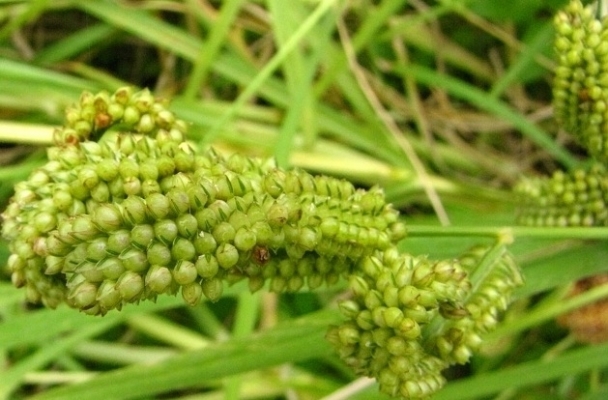




It is known as finger millet, African finger millet, red millet and ragi, are the oldest food and first cereal grain used for domestic purpose. Finger millet is originally native to the Ethiopian highlands and was introduced into India approximately 4000 years ago. They can grow in dry weather; can withstand severe drought conditions and adaptable to higher elevations. These are short duration, ready to harvest as little in 65 days and can be easily grown throughout the year. It is highly grown crops among all small millets. It is a rich source of protein and minerals in comparison to all other cereals and millets. It contains important amino acids. It has the highest amount of calcium (344mg) and potassium (408mg). It is beneficial for individuals with low hemoglobin levels as it is great source of iron.












It can be grown on variety of soil ranging from rich loam to poor shallow upland soil with good organic matter. Black soil with good drainage can also be considered for cultivation as this crop is sustainable to water logging to some extent. Finger millet grows best in soil having pH 4.5-8. Soil having water logging problem should not be used for cultivation of finger millet.
VL Mandua 315: Ready to harvest in 105-115 days. It gives average yield of 10-11 qtl/acre. Tolerant to finger and neck blast.
VL Mandua 324: Released in 2006. Plant attains the height of 77-95cm. Ready to harvest in 105-137 days. It has very light copper colored grain. The variety is moderately tolerant to blast. Gives an average yield of 6-10qtl/acre.
VL Mandua 347: Released in 2011. Plant attains the height of 105-115cm. Ready to harvest in 82-115 days. It has copper colored grain. The variety is moderately tolerant to blast. Gives an average yield of 6-10qtl/acre.
VL Mandua 352: Applicable for cultivation for all states except Tamil Nadu and Maharashtra. Ready to harvest in 95 to 100 days. It gives average yield of 8-10qtl/acre.
GPU 48: Released in 2009. Ready to harvest in 100-105 days. The variety is resistant to blast. Gives an average yield of12-14qtl/acre. Suitable for late kharif and summer season.
GPU 66: Released in 2013. The variety is resistant to blast. Gives an average yield of12-13qtl/acre.
GPU 67: Released in 2010. Ready to harvest in 100-105 days. The variety is resistant to blast. Gives an average yield of12-14qtl/acre. Suitable for late kharif and summer season.
KMR 301: Released in 2011. Ready to harvest in 120 days. It gives average yield of 16-18qtl/acre for rainfed areas and 20-22qtl/acre for irrigated areas. Tolerant to finger and neck blast.
Other state varieties:
PES 400: Ready to harvest in 98-102 days. It gives average yield of 8qtl/acre. It is early maturing variety and it is resistant to blast.
PES 176: Ready to harvest in 102-105 days. Gives average yield of 8-9qtl/acre. Seeds are of brown color and it is resistant to blast.
KM-65: Ready to harvest in 98-102 days. Gives average yield of 8-10qtl/acre.
VL 146: Ready to harvest in 95-100 days. It gives average yield of 98-102qtl/acre. This variety is resistant to blast.
VL 149: Ready to harvest in 98-102 days. Gives average of 10-11qtl/acre. Wide adaptation and earliness and resistant to blast.
VL 124: Ready to harvest in 95-100 days. Average yield 10qtl/acre. Good for seed as well for fodder.
VR 708: It is drought tolerant variety. Applicable for all states for cultivation.
Akshya
PES 110
PR 202
JNR 852
MR 374
1) Cropping Pattern: Crop rotation is very important in finger millet crop. It gives high yield, also minimize use of chemical fertilizer and help to maintain fertility of soil. In north India, for finger millet crop rotation with gram, mustard, tobacco, barley, linseed is commonly followed.
2) Intercropping: In Punjab, finger millet and soybeans are mixed together in 90:100 percent proportion by weight basis and sown is also practiced. Finger millet + soybean in kharif and oats in rabi is an ideal and remunerative cropping sequence for northern hilly region.
In rainfed crop, carry out ploughing operation in main field 2-3 times deeply to conserve moisture in soil. Before sowing secondary tillage with cultivator and multiple tooth hoe to prepare smooth seed bed is necessary. Before sowing do minor land smoothening operations, it helps in better in-situ moisture conservation. In Uttaranchal where frequent ploughing operations are difficult to carry out effective digging and turning of soil, removing perennial weeds, land smoothening, providing inward slope with a shallow drain helps in taking out excess rain water.
Time of sowing
In region of high rainfall, it can be cultivated on well drained soil as transplanted crop. It can be grown as rainfed as well as irrigated conditions. It is grown in all cropping seasons in different parts of country. More than 90% of area is under rainfed conditions, grown during kharif season. In Uttaranchal, it is normally grown in June month.
Spacing
In direct seeding method use row spacing of 20-30cm and for transplanting seedlings use 2 seedlings/hill.
Sowing Depth
Seed should not be sown less than 3-4 cm deep.
Method of sowing
Sowing can be done manually by:
Broadcasting
Line sowing
Drilling
Transplantation in field
Seed Rate
For direct seeding, use seed rate of 4 kg/acre and for transplanting, use 2 kg/acre.
Seed Treatment
Soak seed in water (one litre water for every kg of seeds) for 6 hours. Drain the water and tightly tied the seeds in wet cloth bag for two days. After two days remove seeds from wet cloth bag, they will show some sign of germination. Dry them in shade for two days. Use such seeds for sowing purpose. Treating seeds with Azospirillum brasilense (N fixing bacterium) and Aspergillus awamori (P solubilizing fungus)@25 gm/kg seed is beneficial. If seed treatment with chemicals is to be carried out then, complete chemical seed treatment first and then go for bio chemicals seed treatment before sowing of seeds.
Use any one fungicide/Insecticide from below
| Fungicide/Insecticide name | Quantity (Dosage per kg seed) |
| Thiram | 4gm |
| Captan | 4gm |
| Carbendazim | 2gm |
In areas of adequate moisture, transplantation method is adopted. It gives higher yield compared to direct seeded crop. Transplanted crops do not lodge during heavy rains.
Transplantation method: Sow seeds in well prepared nursery in month of May-June. About 2 kg seeds are required to give enough seedlings to transplant 1 acre of land. For transplantation purpose use three to four weeks old seedlings. Before pulling the seedling, nursery should be irrigated. Prepare slurry with 2 packets 300 gm/acre of Azospirillum inoculant in 40 Ltr of water and dip the root portion of the seedlings in the solution for 15-30 min and transplant. Transplant two seedlings/hill at a distance of 25x8 cm or 25x10 cm and at the depth of 2-3 cm. On third day after transplantation irrigate the field. In absence of timely rain, irrigate the transplanted field regularly till seedlings are well established.
In initial stage of crop, weed control is necessary to obtain good crop growth along with good yield. In line sown crop 2-3 inter-culture operations and one hand weeding is necessary.
For effective weed control take Spray of pre-emergence weedicide like oxyfluorfen @1.25kg/acre or Isoproturon@400ml/acre. Spray, 2-4-D sodium salt@250ml/acre as post-emergent spray around 20-25 days after sowing for effective control of weeds.
As finger millet is rainy season crop it does not required irrigation. But at stage of tillering and flowering, if rain stops for long period then irrigation is necessary for good plant growth along with good yield. Prepared furrows and ridges for irrigation purpose, it serves dual purpose of irrigation and drainage. This crop cannot withstand in waterlogged condition, therefore care should be taken for complete removal of excess water.
| No. of irrigation | Irrigation interval |
| 1st irrigation | Apply immediately after sowing |
| 2nd irrigation | Apply on 3rd day after sowing |
| 3rd irrigation | On 7th day after sowing |
| 4th irrigation | Apply 12th day of sowing |
| 5th irrigation | Apply 18th day of sowing |
Fertilizer Requirement (kg/acre)
| UREA | SSP |
MOP |
| 33 | 54 | 10 |
Nutrient Requirement (kg/acre)
| NITROGEN | PHOSPHORUS | POTASH |
| 16 | 8 | 8 |
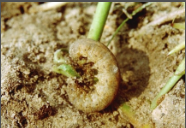
Army and cutworm: Appear in early stage of crop. Caterpillar cut base of plant in early stage of crop. They are active during night and hide in cracks and under stone during day time. They are cyclic in nature
Control: To control cutworm eggs, release Trichogramma parasitoid weekly once for 3 weeks continuously. When the symptoms are noticed take dusting of Malathion 5%@10 kg/acre or Quinalphos 1.5%@250ml/acre. After harvesting remove weeds and stubbles.
Aphid: They occurred throughout the growing period. These are observed on the central leaf whorl and ears. In case of aphid infestation yellowing of leaf is observed. Nymphs of aphid are round in shape and reddish brown in color. Adults are yellow with green legs.
Control: If infestation is observed to control take spray of Methyl demeton 25EC@200ml/acre or Dimethoate 30 EC @200 ml/acre mixed in 100Ltr of water.
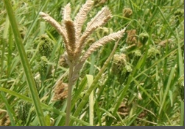
White Stem borer: Larva is found in lower stem region and cause damage. They feed on roots and In severe infestations, center shoots dry up and become yellowish. Larva is milky white in color with yellowish head while adult are dark brownish, white color on forewings.
Control: If infestation is observed, take spray of Carbaryl 50WP@1 kg/150ltr water/acre or Dimethoate 30 EC@200ml/150Ltr of water.
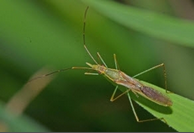
Ear head bug: Adults attack crop on milky stage. They feed on emerging panicle and produces chaffy grains with silky webs. Eggs are of shiny white color and found in cluster with orange hairs. Caterpillars are of brown colors with yellow band and minute hairs. Adults are of brownish color having fibrous forewings and yellowish hindwings.
Control: To attract adult moth place light traps during day time. Place Pheromone trap @5 /acre at flowering stage until panicle stage. In case of severe infestation spray Malathion@400ml or Carbaryl@900gm in 150 ltr water per acre.
Grass hopper: Nymphs and adults feeds on leaves. Nymphs are of whitish color with lines while adults are greenish brown in colour with lines on body.
Control: After harvesting remove all plant remains and follow proper sanitation, cleanliness in the field. Do ploughing after harvesting also in summer so that egg present in soil get exposed to sun and thus get destroyed. At dry and moist conditions apply Entomophthora grylli for grasshopper control. If infestation is observed spray with spray carbaryl 50 WP@900 gm/acre.
Blast: In severe infestation plant gives a blasted or burnt appearance, also lodging of crop is seen. It mostly occurred in Kharif season, at all growth stage. If blast appeared in nursery stage or at ear development stage then severe reduction in yield is observed.
Control: Grow blast resistant varieties. Do seed treatment with fungicide like carbendazim @2 gm/kg before sowing. If symptoms are observed then immediately take spray of any of one fungicides, Carbendazim@500 gm per acre. Second and third sprays at flowering stage at 15 days interval to control neck and finger infection. At 50% earhead emergence, take foliar spray with Aureofungin sol@100 ppm, followed by a second spray after 10 days with Mancozeb@400 gm/acre or Pseudomonas fluorescens@0.2%.
Leaf folder: Leaf folds longitudinally and larva remains inside. They scrap on leaves and thus white patches are observed on leaves. Female lays 200eggs on both side of leaf. Eggs are of yellowish white in color. Larva is of greenish yellow in color with brown or black head. Pupa are of dark brown in color and found inside folded leaf, while adults are whitish yellow or golden yellow.
Control: Rotate crop with non-cereals crops. Keep field and area around field clean. Avoid closer spacing while sowing. Collect and destroyed infected leaf and plant parts away from fields. Spray Chlorpyriphos@2.5ml or Quinalphos@3ml/ltr of water per acre.
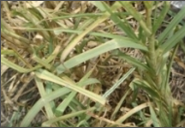
Mosaic: Initially small chlorotic specks are observed around 45 DAS in funnel leaves. Whole plant shows yellow appearance in severe infestation. Infected plants produce more of nodal branches and unproductive tillers.
Control: If symptoms are observed then uproot and removed the infected plant and destroyed away from field. Take spray of Methyl demeton @ 25EC 200 ml/acre. If required take second spray with intervals of 20 days.
Generally crops matures in 120-135days, duration may vary depending upon variety use. Harvesting is done in two stages. Earheads are harvested with sickles and straw is cut close to ground. Earheads are heap and then drying is done in sun for three to four days. After good drying threshing is carried out. In some places whole plant along with earhead is cut, heap and dry in sun for 2-3 days and then threshed.
Malting of finger millet is a traditional process followed in India and is used in infant foods and in milk thickener formulations, conveniently called ragi malt and is used in the preparation of milk beverages. A fermented drink or beer is also prepared from the grain in some parts of the country.
You have successfully login.
Your email and password is incorrect!